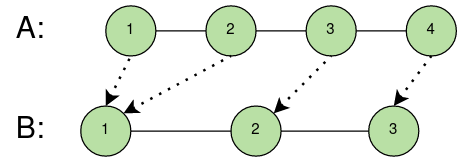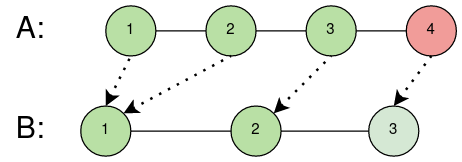Fixed vs. latest
Your software A depends on another piece of software B. Should you build against a fixed version of B or always get the latest?
Let’s look at a specific example. Let’s say that we have two source control repositories for A and B, with Alex and Bob changing, maintaining and responsible for each respectively.
Alex’s component A depends on Bob’s component B.
Should Alex configure the build system for A to take the last build of B or should it configure it to get a fixed known good build of B? Which option is the best?
Latest
Alex and Bob work a new exciting project, they coordinate with each other constantly.
Alex configures the build system for A to take the last build of B.

This has the advantage that it creates a happy path for getting (presumably good) changes from B:
- Bob changes B
- Bob rebuilds B
- Alex rebuilds A
Now component A has all new functionality/fixes in B. Alex and Bob are happy, job done.
However there is the unhappy path:
- Alex changes A
- Alex rebuilds A
- The build of A fails
- Alex is confused, he did not expect the build to fail
- Alex investigates
- It turns out that Bob did a change in B, that latest change in B was automatically picked and it breaks the build of A

How much this disadvantage is a problem depends on:
- How often it happens
- What’s the time lost investigating
- What’s the delay of detecting the breaking change: while building A, or much Later (if the change is subtle and breaks functionality, but not build/existing automated tests)
- How many people are impacted: is it just Alex, or a team of developers that have their builds of A fail?
- How quickly Bob can fix the issue
Fixed
Alex has had enough of component A builds failing when Bob changed component B without realising (or caring for) the impact of Bob’s change.
Alex configures the build system for A to take a specific/fixed build of B that is first tested and known to be good.

The advantage is that Alex has control over when new version of B are taken. So when Alex takes a new version of B which breaks the build of A, he knows that the cause has to do with changes in the new version of B.
The disadvantages of this approach are that:
- Propagating changes from B to A requires the additional step to change A to refer to the newer build of B. The effort required depends on the specifics of the build system used
- It creates a maintenance activity to periodically take new versions of B
- When taking a new version of B breaks the build of A there could have done many changes to B causing the issue: that will take time investigating
Lesson
First: there is no solution that is best overall. Each approach has advantages and disadvantages, which one is taken depends on the context, but each choice comes with consequences.
Second: the issue generalises for other situations where a component depends on another, not just the specific example above. Maybe component B are binaries produced by a third party or part of the operating system.
Third: sometimes the problem can be avoided e.g. if the components are consolidated in the same source control repository, or for small projects where Alex and Bob are really a single person, there also options regarding how often a fixed version is taken.